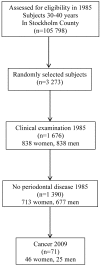History of dental infections associates with cancer in periodontally healthy subjects: a 24-year follow-up study from sweden
- PMID: 24494025
- PMCID: PMC3909762
- DOI: 10.7150/jca.7402
History of dental infections associates with cancer in periodontally healthy subjects: a 24-year follow-up study from sweden
Abstract
Background: Infections of teeth are highly prevalent, often leading to tooth extractions. Missing teeth can thus be considered as proxy for chronic dental infections, caries or periodontitis. We followed-up a cohort for 24 years investigating the association between missing teeth and the incidence of cancer with the hypothesis that dental chronic inflammation links to cancer.
Methods: WHO ICD-7-9-10 malignant diagnoses were recorded from the Swedish Cancer Registry from 1985 to 2009 in 1 390 individuals who had underwent clinical oral examination in 1985. The subjects appeared periodontally healthy and thus the probable reason for tooth extractions was deep caries. Using Fisher's exact t-test and multiple logistic regression analysis the results were analysed for the association between cancer incidence and baseline oral health parameters and a number of other explanatory factors.
Results: Of the 1 390 subjects 71 had got cancer by year 2009. The results of the multiple regression analysis showed that between any type of cancer as a dependent variable, and several independent explanatory variables, missing second molar in the right mandible and age appeared as the principle independent predictors significantly associating with cancer, with an odds ratio (95% confidence interval) of 2.62 (1.18-5.78) and 1.91 (1.06-3.43), respectively.
Conclusions: In periodontally healthy subjects extracted molars, proxy for past dental infections, seemed to predict cancer risk in the studied age group - hence supporting a role of chronic dental infection/inflammation in carcinogenesis.
Keywords: Cancer.; Dental infections; Extracted molars; Periapical infection.
Conflict of interest statement
Competing Interests: The authors have declared that no competing interest exists.
Figures
Similar articles
-
Twenty-year follow-up of root filled teeth in a Swedish population receiving high-cost dental care.Int Endod J. 2016 Jul;49(7):636-45. doi: 10.1111/iej.12495. Epub 2015 Jul 20. Int Endod J. 2016. PMID: 26139565
-
Periodontal disease may associate with breast cancer.Breast Cancer Res Treat. 2011 Jun;127(2):497-502. doi: 10.1007/s10549-010-1221-4. Epub 2010 Oct 20. Breast Cancer Res Treat. 2011. PMID: 20960226
-
Osseointegrated implants in subjects treated for generalized aggressive periodontitis: 10-year results of a prospective, long-term cohort study.J Periodontol. 2007 Dec;78(12):2229-37. doi: 10.1902/jop.2007.070201. J Periodontol. 2007. PMID: 18052693
-
Surgical removal versus retention for the management of asymptomatic disease-free impacted wisdom teeth.Cochrane Database Syst Rev. 2020 May 4;5(5):CD003879. doi: 10.1002/14651858.CD003879.pub5. Cochrane Database Syst Rev. 2020. PMID: 32368796 Free PMC article.
-
Indications for extraction of third molars: a review of 1763 cases.Niger Postgrad Med J. 2008 Mar;15(1):42-6. Niger Postgrad Med J. 2008. PMID: 18408783 Review.
Cited by
-
Autoimmune Diseases and Oral Health: 30-Year Follow-Up of a Swedish Cohort.Dent J (Basel). 2017 Dec 22;6(1):1. doi: 10.3390/dj6010001. Dent J (Basel). 2017. PMID: 29563402 Free PMC article.
-
Dental infections may have detrimental consequences.J R Soc Med. 2014 Jun;107(6):218. doi: 10.1177/0141076814537434. Epub 2014 Jun 9. J R Soc Med. 2014. PMID: 24912789 Free PMC article. No abstract available.
-
Oral Infections and Systemic Health - More than Just Links to Cardiovascular Diseases.Oral Health Prev Dent. 2021 Sep 11;19:441-448. doi: 10.3290/j.ohpd.b1993965. Oral Health Prev Dent. 2021. PMID: 34505498 Free PMC article. Review.
-
The impact of inflammatory bowel disease on oral health.Br Dent J. 2017 Apr 7;222(7):549-553. doi: 10.1038/sj.bdj.2017.318. Br Dent J. 2017. PMID: 28387295 Review.
-
Periodontal Disease and Risk of Bladder Cancer: A Meta-Analysis of 298476 Participants.Front Physiol. 2018 Jul 23;9:979. doi: 10.3389/fphys.2018.00979. eCollection 2018. Front Physiol. 2018. PMID: 30083109 Free PMC article.
References
-
- Trovik TA, Klock KS, Haugejorden O. Trends in reasons for tooth extractions in Norway from 1968 to 1998. Acta Odontol Scand. 2000 Apr;58(2):89–96. - PubMed
-
- Spalj S, Plancak D, Juric H, Pavelic B, Bosnjak A. Reasons for extraction of permanent teeth in urban and rural populations of Croatia. Coll Antropol. 2004 Dec;28(2):833–839. - PubMed
-
- Fischetti VA. Novel method to control pathogenic bacteria on human mucous membranes. Ann N Y Acad Sci. 2003 Apr;987:207–214. - PubMed
-
- Tachibana M, Yoshida A, Ansai T, Takata Y, Akifusa S, Fukuhara M. et al. Prevalence of periodontopathic bacteria on the tongue dorsum of elderly people. Gerodontology. 2006 Jun;23(2):123–126. - PubMed
LinkOut - more resources
Full Text Sources
Other Literature Sources
Miscellaneous



